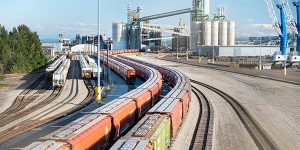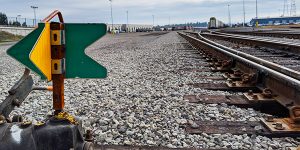Following the tracks: POV’s rail crew and the community
Driving along the Columbia River, whether it’s the Interstate 5 corridor, State Route 14 or through the Gorge on Interstate 84, you see the true economic impact of our region – trucks transporting wind blades, tugs and barges moving grain and trains rolling down the tracks. Each mode of transportation is critical to our local and global supply chains as these products move from place to place. Let’s take a closer look at the importance of the port’s rail infrastructure to the community and what (or rather who) makes it stand out above the rest.

Over 69,000 railcars moved through the port in 2019
Impacts to the community:
It can be challenging to make the connection between rail activity and benefits to the local economy, but in the SW Washington region, the impact is truly significant.
Take grain as an example. Did you know that the Columbia River is number one in the US for wheat exports and number two and three for corn and soy? Here at the port, grain continues to be our largest export commodity by volume and our tenant, United Grain Corporation, operates the largest grain facility on the West Coast moving wheat, soybeans and corn to primarily Asian markets. Some of these grains come back to us as crackers, breads and the noodles we enjoy. Ten percent of US wheat exports flow through our facilities.
Not only are we involved in the movement of goods from train to vessel, but this operation indirectly supports the farmers in rural areas who need an export opportunity, as well as the jobs that occur at the port’s terminal. These could be tenants, longshore workers, river and bar pilots and so many more as the commodity makes its way to its final destination.
Infrastructurally speaking:
As we’ve described above, rail is a major component of how commodities move across the US and at the port, the quality of our rail infrastructure is one of the best in the business.

There are 168 rail switches within the port’s 42-mile track system
In 2018, we completed our West Vancouver Freight Access Project (WVFA). This was a concerted, decade-long effort by the port to create jobs and generate economic benefit by investing in freight rail infrastructure. WVFA improves freight rail movement through the port and along the BNSF Railway and Union Pacific Railroad mainlines, connecting the Pacific Northwest to major rail hubs in Chicago and Houston, and from Canada to Mexico. The completion of WVFA also provides new business opportunities and jobs for Southwest Washington.
“In 2019, we had a record-breaking year and moved over 69,000 railcars through the port,” said port Rail Manager, Wayne Harner. “WVFA continues to have significant positive impacts on the flow of rail traffic locally and regionally.”
Prior to WVFA, the port’s track footage was only 16 miles – now it’s 42 miles. The port’s invaluable rail crew maintains all 42 miles keeping the tracks in top shape for the trains that move through the port. Over 20 businesses are rail-served with a majority being port tenants, adding another layer to the complexity and importance of the port’s rail infrastructure.
Rail is a vital component not only with port operations, but with the supply chain as a whole. The port is strategically located at a major nexus of ocean and river shipping lanes, two interstate highways, and a continent-spanning rail network, setting us up as a dynamic hub of global trade.
Through a combination of the rail crew’s expertise and the WVFA project, the Port of Vancouver stands above the rest when it comes to rail operations.
